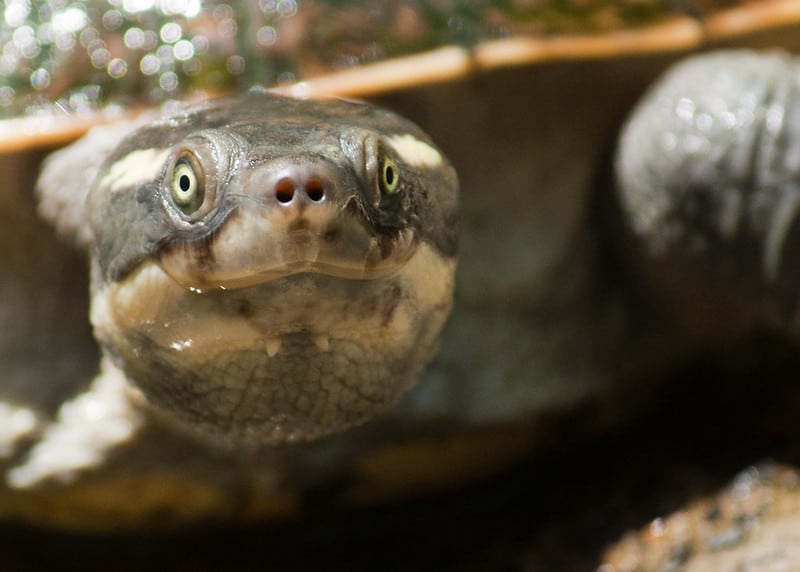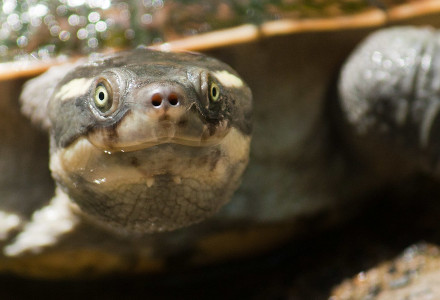
Mary River Turtle Facts
- This intriguing product of Nature and evolution most frequently goes by the somewhat informative common name of the Mary River Turtle. For the moment, unlike many of its brethren, the remarkable reptile has no other generally accepted general name.
- Scientific professionals, such as researchers, however, most often refer to it by the its formal scientific name. That, though, is the less easily pronounced term of Elusor macrurus. Regardless of the name used, however, it remains a most unusual creature.
- The researchers John Cann and John Legler hold the distinction of making the first formal recognition of the animal as a separate and distinct species. This scientifically noteworthy action, however, only occurred in very recent time, in the year 1994, in fact.
- Lamentably, though, the impressive Mary River Turtle does not appear to have either a large or extensively spread population base. Due to this, the IUCN presently lists the animal as Endangered. That status currently appears on the organization’s Red List.
- Given the nature and location of its known habitat range, habitat loss understandably poses a very serious threat to the continued existence of the Mary River Turtle. The greatest danger it faces, though, most likely consists of the effects of climate change.
Related Articles
Mary River Turtle Physical Description
The eye-catching Mary River Turtle clearly draws the attention of those who encounter it. It actually has several characteristics that make it an intriguing reptile. Most people consider its sheer appearance, however, to be its most astonishing physical feature.
The sheer size of the turtle also deserves mention, though. In fact, while no giant, it represents one of the largest of all turtles in its region of the world. Like many related creatures, it further displays a marked degree of the physiological trait of sexual dimorphism.
In its case, however, the males of the species typically attain a greater size than their female counterparts. Among many turtles, the opposite pattern holds true. Males reach an average 16.5 in (42 cm) in carapace length, and an impressive weight of 12.1 lb (5.44 kg).
The females of the remarkable species, meanwhile, usually reach carapace lengths of only around 13.4 in (34 cm), and weights of about 7.7 lb (3.5 kg). Exceptional specimens of both genders do occasionally occur, however. Some measure up to 19.7 in (50 cm).
Otherwise the genders appear indistinguishable. The carapace generally has an elongatged shape. Overall color, meanwhile, tends to be combinations of shades of reddish-brown to black. Some individuals also develop growths of algae on their heads!
- Kingdom: Animalia
- Phylum: Chordata
- Class: Reptilia
- Order: Testudines
- Family: Chelidae
- Genus: Elusor
- Species: E. macrurus
Mary River Turtle Distribution, Habitat, and Ecology
Unfortunately, both for the Mary River Turtle itself, as well as those of us who appreciate Nature, it has an extremely restricted habitat range. For now, the magnificent animal only appears to live in one tiny segment of the always fascinating continent of Australia.
Even there, however, the unusual reptile seems to be limited to only one highly specific region. The name itself actually supplies a hint of that location. That’s because the known habitat of the Endangered reptile consists of the small Mary River, in southeast Queensland.
Yet, even within this already highly limited zone of habitation, the turtle displays very specific preferences in terms of where it lives. Virtually all known specimens make their home in regions of strongly flowing, well oxygenated sections of the river and its streams.
Researchers currently know very little about the ecology of this marvel of Nature. Those studying the species do know, however, that although it spends most of its time in the water, it makes its nests on land. These rarely appear very far from the water, though.
Like most of its relatives, it does appear that it evolved as an omnivorous creature. Among the vegetation it consumes, algae seems to predominate its choices. Its animal prey, meanwhile, largely consists of such small choices as molluscs and other small species.
The lifespan of the Mary River Turtle remains undetermined, for the moment. Interestingly, though, females tend to reach physical maturity slightly faster than the males. Females attain this state in approximately 25 years, but males typically take roughly 30 years.
Species Sharing Its Area
Check out our other articles on Berca Mud Volcanoes, Mycena Chlorophus, Giant Manta Ray, Onyx River, California red-sided garter snake, Eight-Spotted Forester Moth

